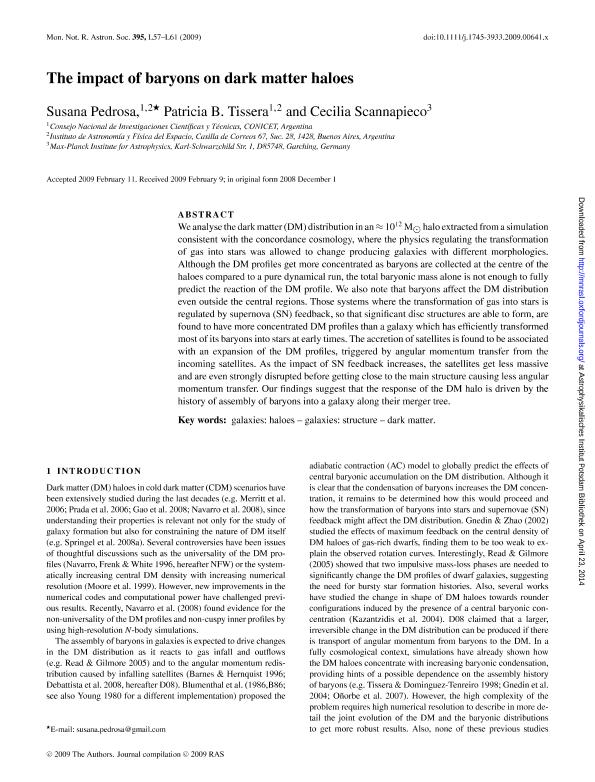Mostrar el registro sencillo del ítem
dc.contributor.author
Pedrosa, Susana Elizabeth

dc.contributor.author
Tissera, Patricia Beatriz

dc.contributor.author
Scannapieco, Cecilia

dc.date.available
2017-08-03T21:05:54Z
dc.date.issued
2009-05
dc.identifier.citation
Pedrosa, Susana Elizabeth; Tissera, Patricia Beatriz; Scannapieco, Cecilia; The impact of baryons on dark matter haloes; Oxford University Press; Monthly Notices of the Royal Astronomical Society; 395; 1; 5-2009; L57-L61
dc.identifier.issn
0035-8711
dc.identifier.uri
http://hdl.handle.net/11336/21846
dc.description.abstract
We analyse the dark matter (DM) distribution in an ≈1012 M halo extracted from a simulation consistent with the concordance cosmology, where the physics regulating the transformation of gas into stars was allowed to change producing galaxies with different morphologies. Although the DM profiles get more concentrated as baryons are collected at the centre of the haloes compared to a pure dynamical run, the total baryonic mass alone is not enough to fully predict the reaction of the DM profile. We also note that baryons affect the DM distribution even outside the central regions. Those systems where the transformation of gas into stars is regulated by supernova (SN) feedback, so that significant disc structures are able to form, are found to have more concentrated DM profiles than a galaxy which has efficiently transformed most of its baryons into stars at early times. The accretion of satellites is found to be associated with an expansion of the DM profiles, triggered by angular momentum transfer from the incoming satellites. As the impact of SN feedback increases, the satellites get less massive and are even strongly disrupted before getting close to the main structure causing less angular momentum transfer. Our findings suggest that the response of the DM halo is driven by the history of assembly of baryons into a galaxy along their merger tree.
dc.format
application/pdf
dc.language.iso
eng
dc.publisher
Oxford University Press

dc.rights
info:eu-repo/semantics/openAccess
dc.rights.uri
https://creativecommons.org/licenses/by-nc-sa/2.5/ar/
dc.subject
Galaxies Haloes
dc.subject
Galaxies Structure
dc.subject
Dark Matter
dc.subject.classification
Astronomía

dc.subject.classification
Ciencias Físicas

dc.subject.classification
CIENCIAS NATURALES Y EXACTAS

dc.title
The impact of baryons on dark matter haloes
dc.type
info:eu-repo/semantics/article
dc.type
info:ar-repo/semantics/artículo
dc.type
info:eu-repo/semantics/publishedVersion
dc.date.updated
2017-07-28T15:05:38Z
dc.journal.volume
395
dc.journal.number
1
dc.journal.pagination
L57-L61
dc.journal.pais
Reino Unido

dc.journal.ciudad
Oxford
dc.description.fil
Fil: Pedrosa, Susana Elizabeth. Consejo Nacional de Investigaciónes Científicas y Técnicas. Oficina de Coordinación Administrativa Ciudad Universitaria. Instituto de Astronomía y Física del Espacio. - Universidad de Buenos Aires. Facultad de Ciencias Exactas y Naturales. Instituto de Astronomía y Física del Espacio; Argentina
dc.description.fil
Fil: Tissera, Patricia Beatriz. Consejo Nacional de Investigaciónes Científicas y Técnicas. Oficina de Coordinación Administrativa Ciudad Universitaria. Instituto de Astronomía y Física del Espacio. - Universidad de Buenos Aires. Facultad de Ciencias Exactas y Naturales. Instituto de Astronomía y Física del Espacio; Argentina
dc.description.fil
Fil: Scannapieco, Cecilia. Gobierno de la Republica Federal de Alemania. Max Planck Institut Fur Astrophysik; Alemania. Consejo Nacional de Investigaciones Científicas y Técnicas; Argentina
dc.journal.title
Monthly Notices of the Royal Astronomical Society

dc.relation.alternativeid
info:eu-repo/semantics/altIdentifier/doi/http://dx.doi.org/10.1111/j.1745-3933.2009.00641.x
dc.relation.alternativeid
info:eu-repo/semantics/altIdentifier/url/https://academic.oup.com/mnrasl/article-lookup/doi/10.1111/j.1745-3933.2009.00641.x
dc.relation.alternativeid
info:eu-repo/semantics/altIdentifier/url/https://arxiv.org/abs/0902.2100
Archivos asociados
